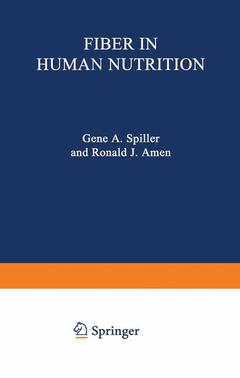Fiber in Human Nutrition, Softcover reprint of the original 1st ed. 1976
Langue : Anglais
Coordonnateur : Spiller Gene

The editors have designed this book to serve both as a textbook on fiber in nutrition and, we hope, as the first complete reference on the subject. For the past 25 years, the study of plant fibers and their effect on human physiology has generally been relegated to a low-priority status. Recently, however, this area of research has enjoyed a renaissance unparalleled in the history of the food and nutritional sciences, a reawakening which has occurred primarily as a result of epidemiology reports that suggested a positive relationship between plant fiber ingestion and health. As interest among the scientific community increased and new research programs were initiated to test objectively the epidemiological hypotheses, major gaps in the fundamental pool of knowledge became apparent. To compound the difficulty, scientists often did not agree upon what "fiber" is. Some investigators restricted their definition to the structural polymers of the plant, while others expanded theirs to include the entire plant cell wall with all its fibrous and associated nonfibrous substances. As a result, research that was performed and reported frequently only obscured the issue still further; at best it exposed whole new areas of ignorance in a field once considered too uninteresting to pursue. Despite voluminous research, scientists generally have still not been able to identify with certainty the specific component(s) of the plant cell-wall system that causes the various observed physiological effects. In fact, they do not yet agree upon the nomenclatures involved.
1 What Is Fiber?.- I. Introduction.- II. Development of the Concept of Fiber in Human Nutrition.- III. The Plant Cell Wall.- IV. Components of Fiber and Their Possible Physiological Significance.- V. Fiber-Associated Substances.- VI. Conclusion.- 2 The Chemistry of Dietary Fiber.- I. Introduction.- II. The Chemistry of the Individual Components.- III. Arrangement and Distribution of the Components of Dietary Fiber in Foods.- IV. Conclusions.- 3 The Analysis of Dietary Fiber.- I. Introduction and Historical Review.- II. Measurement of Fiber.- III. Measurement of Constituents of the Plant Cell Wall.- IV. Unified Procedures for Measurement of Unavailable Carbohydrates, Indigestible Residue, and Dietary Fiber.- V. Conclusions: Choice of Analytical Procedures in Studies of Dietary Fiber.- 4 Physical Properties of Fiber: A Biological Evaluation.- I. Introduction.- II. Physical Properties of Living Plant Fiber.- III. Preparation of Vegetable Fiber for Physical Characteristics Studies.- IV. Water Adsorption.- V. Ion-Exchange Capacity.- VI. Adsorption of Organic Materials to Vegetable Dietary Fiber.- VII. Surface Properties.- VIII. Relationship between Fiber and Bacteria.- IX. Effect of Bacteria on Solutes.- X. Matrix Bacterial-Solute Interaction.- XI. Summary.- 5 Microbial Activities Related to Mammalian Digestion and Absorption of Food.- I. Introduction.- II. Fermentation.- III. Food Effects on Host-Microbe Relationships.- IV. The Competition Model.- V. The Cooperation Model, with Preacid Fermentation.- VI. The Cooperation Model, with Postacid Fermentation.- VII. Types of Microorganisms.- VIII. Abnormalities in Alimentary Fermentations.- IX. Other Effects of the Microbial Ecosystem on the Host.- X. Summary and Conclusion.- 6 The Use and Function of Fiber in Diets of Monogastric Animals.- I. Introduction.- II. Fiber in Natural-Ingredient Diets.- III. Fiber in Semipurified Diets.- IV. Theories on the Health-Benefiting Role of Fiber in Diets.- V. Experimental Studies with Dietary Fiber.- VI. Conclusion.- 7 Dietary Fiber and Lipid Metabolism.- I. Introduction.- II. Early Studies.- III. Effect of Fiber on Lipids and Atherosclerosis.- IV. Possible Mechanisms of Action.- V. Summary and Conclusions.- 8 Dietary Fiber and Colon Function.- I. Introduction.- II. Effect of Fiber.- III. Dietary Fiber and Diverticular Disease.- IV. Dietary Fiber and Colonic Cancer.- V. Summary.- 9 Epidemiology of Bowel Disease.- I. Introduction.- II. Considerations in the Epidemiology of Bowel Disease.- III. Artifacts in Interpretation.- IV. Hemorrhoids.- V. Appendicitis.- VI. Constipation, Intestinal Stasis, and Consequences.- VII. Diverticular Disease.- VIII. Cancer of the Bowel.- IX. Volvulus of the Colon.- X. Inflammatory Bowel Disease.- XI. Summary.- 10 Gastrointestinal Diseases and Fiber Intake with Special Reference to South African Populations.- I. Introduction.- II. General Pattern of Changes in Diseases and Diet.- III. Diets of South African Populations.- IV. Pattern of Gastrointestinal Diseases in South African Populations.- V. Discussion.- VI. Summary.- 11 The Effects of Dietary Fiber: Are They All Good?.- I. Introduction.- II. The Evidence of Geographic Pathology.- III. The Validity of Assumptions.- IV. Proven Advantages of Dietary Fiber in Man.- V. Some Possible Side Effects of Dietary Fiber.- VI. Sources of Confusion.
Date de parution : 03-2012
Ouvrage de 278 p.
15.2x22.9 cm
Thème de Fiber in Human Nutrition :
© 2024 LAVOISIER S.A.S.


